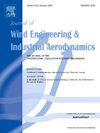评估湍流模型对 WRF-LES 分离湍流流经三维山丘的影响
IF 4.9
2区 工程技术
Q1 ENGINEERING, CIVIL
Journal of Wind Engineering and Industrial Aerodynamics
Pub Date : 2024-10-17
DOI:10.1016/j.jweia.2024.105910
引用次数: 0
摘要
与传统的CFD模式相比,天气研究与预报模式(WRF)能更真实地再现台风等极端天气灾害下复杂的时空变化风场。然而,WRF(WRF-LES)预测工程尺度湍流的大涡模拟模式在不同的湍流模型方面还有待明确。本研究选择了一个三维山丘作为研究对象。我们以经过三维山丘的分离流为研究对象,系统地重新审视了四种湍流模型(SMAG、TKE、NBA1、NBA2)的影响。结果表明,在默认条件下,四种经典湍流模型只能在一定程度上再现山丘分离后的湍流结构,而非线性模型(NBA1 和 NBA2)比线性模型(SMAG 和 TKE)模拟了更多的发夹涡和小尺度涡旋结构。然后,通过调整四个经典 WRF-LES 湍流模型的关键参数,阐明了参数敏感性。结果表明,线性模型模拟分离流和小尺度涡旋结构的能力对涡旋粘度系数很敏感。使用非线性模型后,模拟结果对反向散射系数的变化不敏感。本文章由计算机程序翻译,如有差异,请以英文原文为准。
Assessment of turbulence model effects on WRF-LES of separated turbulent flows past a 3D hill
Compared to traditional CFD models, weather research and forecasting model (WRF) can more realistically reproduce complex spatio-temporally varying wind fields under extreme weather disasters like typhoon. However, the large-eddy simulation mode of WRF (WRF-LES) to predict engineering-scale turbulence has yet to be clarified in terms of different turbulence models. This study selected a three-dimensional hill as the research object. We focus on separated flow past a 3D hill to systematically revisit the influence of four turbulence models (SMAG, TKE, NBA1, NBA2). The results show that four classical turbulence models under the default conditions can only reproduce the turbulent structure of the post-hill separation to a certain extent and that the nonlinear models (NBA1 and NBA2) simulate more hairpin vortices and small-scale vortex structures than the linear models (SMAG and TKE). Then, the parameter sensitivity is clarified by adjusting key parameters of four classical WRF-LES turbulence models. The results show that the ability of the linear models to simulate the separated flow and small-scale vortex structure is sensitive to the vortex viscosity coefficient. Once the nonlinear models are used, the simulation results are insensitive to the backscatter coefficient variation.
求助全文
通过发布文献求助,成功后即可免费获取论文全文。
去求助
来源期刊
CiteScore
8.90
自引率
22.90%
发文量
306
审稿时长
4.4 months
期刊介绍:
The objective of the journal is to provide a means for the publication and interchange of information, on an international basis, on all those aspects of wind engineering that are included in the activities of the International Association for Wind Engineering http://www.iawe.org/. These are: social and economic impact of wind effects; wind characteristics and structure, local wind environments, wind loads and structural response, diffusion, pollutant dispersion and matter transport, wind effects on building heat loss and ventilation, wind effects on transport systems, aerodynamic aspects of wind energy generation, and codification of wind effects.
Papers on these subjects describing full-scale measurements, wind-tunnel simulation studies, computational or theoretical methods are published, as well as papers dealing with the development of techniques and apparatus for wind engineering experiments.

 求助内容:
求助内容: 应助结果提醒方式:
应助结果提醒方式:


